1. Root Bridges of India
In the depths of northeastern India, in one of the wettest places on earth, bridges aren't built -- they're grown.
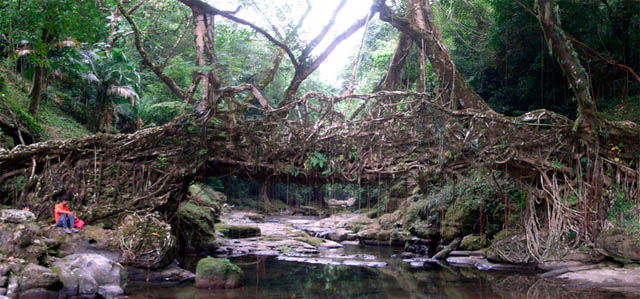

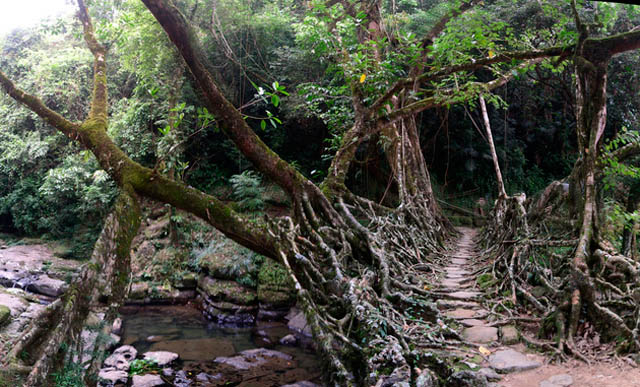
(images credit: Vanlal Tochhawng)
Grown from the roots of a rubber tree, the Khasis of Cherapunjee use betel nut trunks, sliced down the middle and hollowed out, to create "root-guidance systems." When they reach the other side of the river, they're allowed to take root in the soil. Given enough time, a sturdy, living bridge is produced.

(image via)
The root bridges, some of which are over a hundred feet long, take ten to fifteen years to become fully functional, but they're extraordinarily strong. Some can support the weight of 50 or more people at once.
One of the most unique root structures of Cherrapunjee is known as the "Umshiang Double-Decker Root Bridge." It consists of two bridges stacked one over the other!
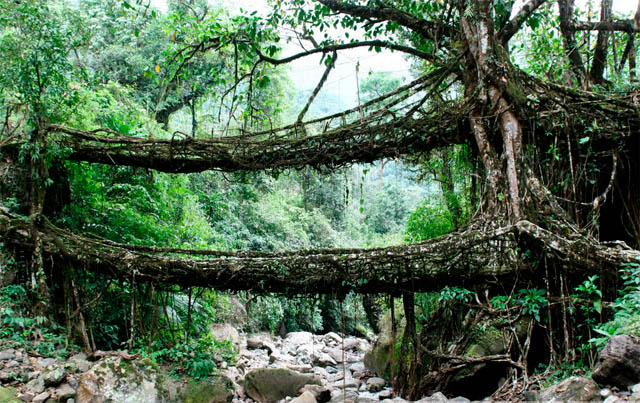

(images credit: Marcus Fornell, Jim Ratcliffe)
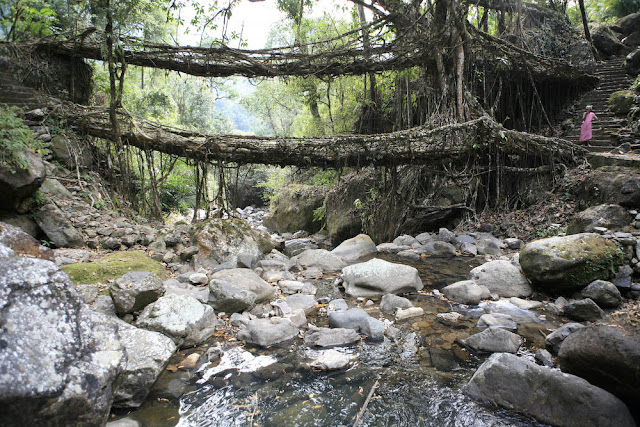
(image via 1, 2)
Because the bridges are alive and still growing, they actually gain strength over time, and some of the ancient root bridges used daily by the people of the villages around Cherrapunjee may be well over 500 years old.
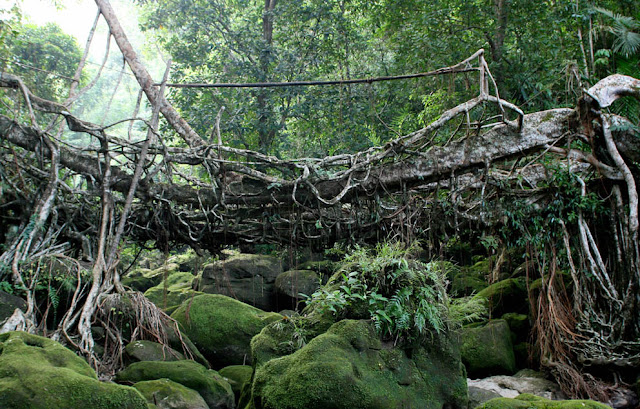
(image credit: Marcus Fornell)
But these are not the only bridges built from growing plants. Japan too, has its own form of living bridges.
2. The Vine Bridges of Iya Valley

(image via)
One of Japan's three "hidden" valleys, West Iya is home to the kind of misty gorges, clear rivers, and thatch-roofed houses that one imagines in the Japan of centuries ago. To get across the Iya River that runs through the rough valley terrain, bandits, warriors and refugees created a very special, if unsteady, type of bridge made of vines.
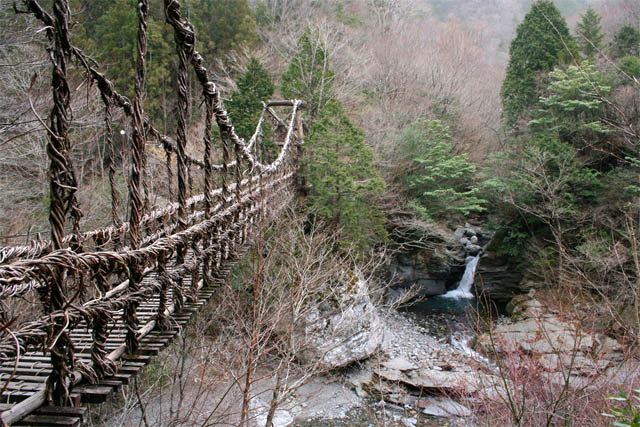
(image via)
This is a picture from the 1880s of one of the original vine bridges.

(image via)
First, two Wisteria vines -- one of the strongest vines known -- were grown to extraordinary lengths from either side of the river. Once the vines had reached a sufficient length they were woven together with planking.
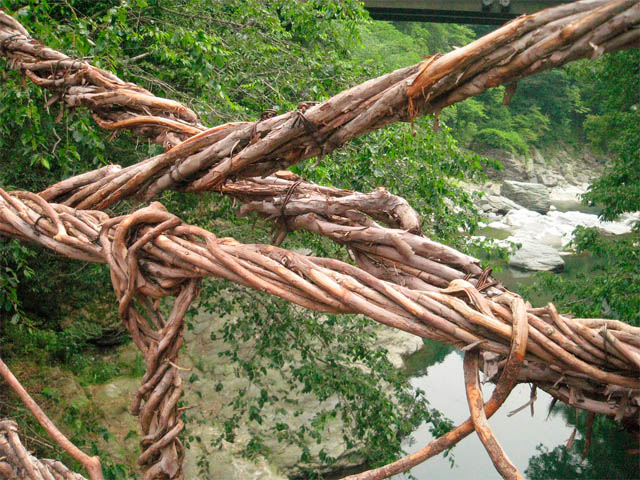

(images via 1, 2)
The bridge had no sides, and a Japanese historical source relates that the original vine bridges were so unstable, that when those attempting to cross them for the first time would often freeze in place, unable to go any farther.
Three such vine bridges remain in Iya Valley. While some (though apparently not all) of the bridges have been reinforced with wire and side rails, they are still harrowing to cross. More than 140-feet long, with planks set six to eight inches apart, and a drop of four and a half stories down to the water, they are not for acrophobes.
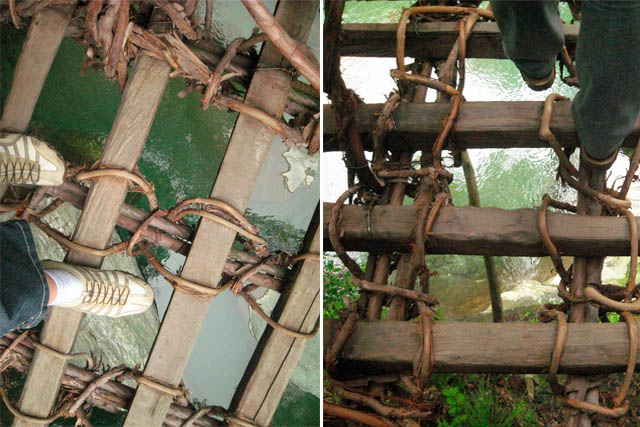
(images via 1, )
Some people believe that these existing vine bridges were first built in the 12th century, which would make them some of the oldest known pieces of living architecture in the world. But there is one group of ancient peoples who took living architecture to an entirely new level.
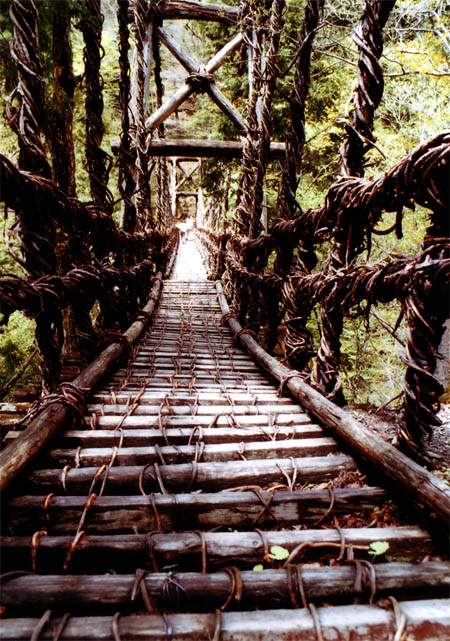
(image via)
3. The Living Islands of the Uros People
The Uros people's lives revolve around reeds. They make reed houses, reed boats, reed flower tea, and use reeds as medicine.
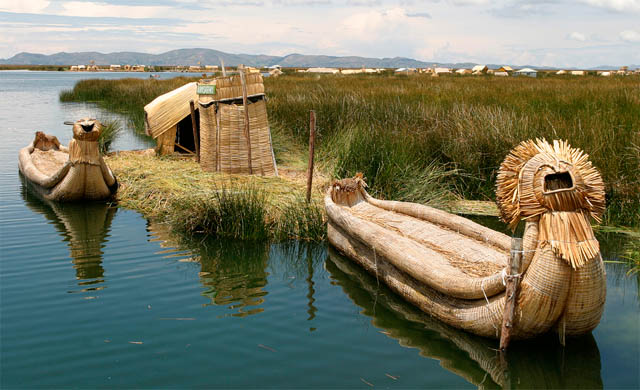

(image credit: Benjamin)
But most amazingly, the Uros build entire islands out of living reeds. It is the fact that these islands are alive that makes them work. The dense root structures of the living reed masses keeps the whole island together and floating on the lake.
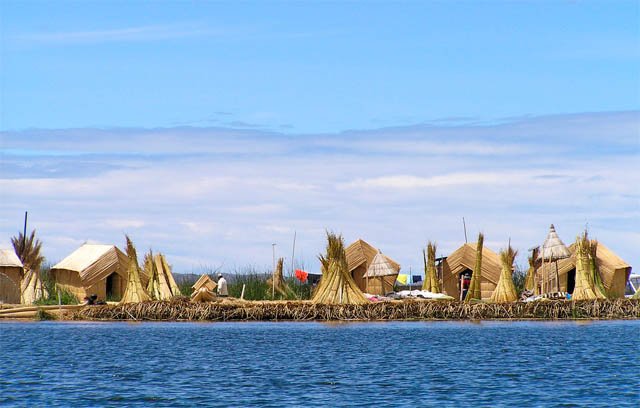

(images via 1, 2 )
As reeds disintegrate from the bottom of the islands, which are four to eight feet thick, residents must add more to the surface. The entire island moves slightly with the water, similar to the feeling of lying on a waterbed. The Uros, however, have gotten quite used to it, as have the cats, fowl and other animals that live among these floating islands.

(images via 1, 2)
The Uros have been living on these floating islands since the 1500s when they were forced to take up residence on lake Titicaca after the Incans expanded into their terrestrial territory. While many of the islands are moored to the bottom of the lake, they can be moved if necessary. One of the main advantages to living on a floating island is that when the enemy comes too close, you can just float the other way.
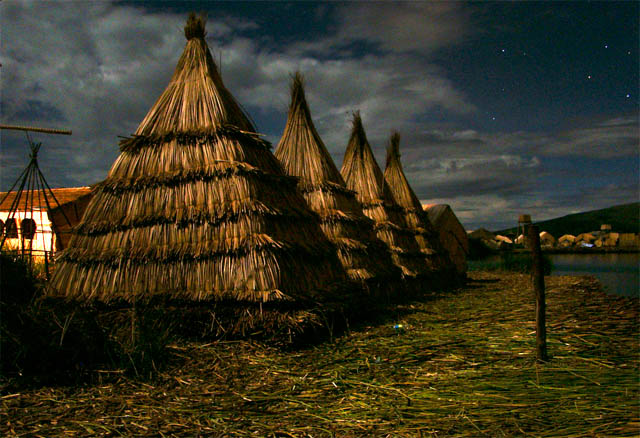
(image via)
Even tiny outhouse islands have been created, on which the living roots help absorb the waste.

(image via)
Today, in the shadow of the Andes, on the world’s highest navigable lake, hundreds of Uros (or descendants of the Uros depending on how you define them) live on these floating islands and make their living from fishing and from selling their reed handicrafts to tourists.


4. "Espalier" Art Form
Another more common form of ancient tree shaping is known as espalier. Espalier is the process of making two-dimensional forms out of trees. A popular practice in Medieval times, the craft likely dates back to ancient Egypt. Espalier can be used to make ornamental trees, increase the yield of a fruit tree, or build a fence or wall from growing trees.
On Pacific Street in Pacific Heights, San Francisco:
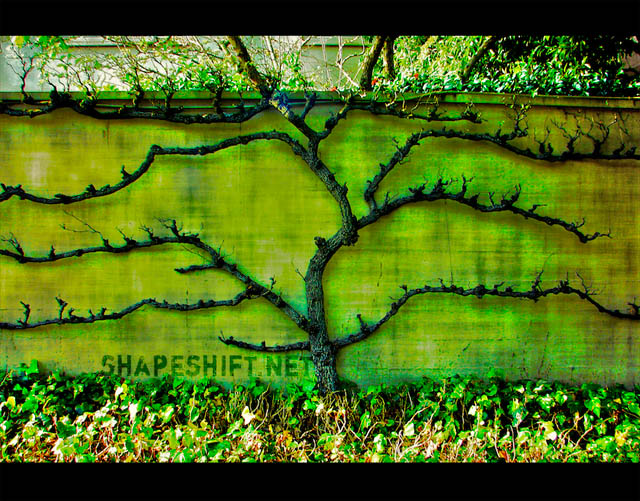
(image credit: David Pham, ShapeShift.net)
One of the more famous examples of espalier can be seen at the Cloisters in Manhattan, New York:
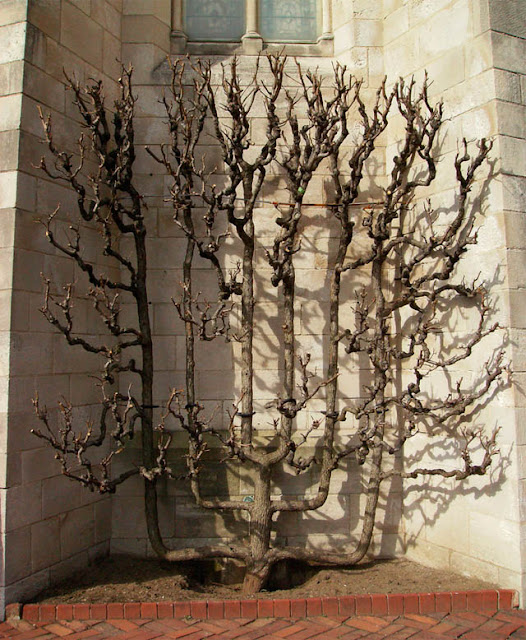
(image via)

(A Living Menorah in Illinois, Allerton Park - image via)
Of course, not all living architecture is about building or shaping things out of trees. Sometimes it makes sense to build things inside of them...
5. The Chapel Oak
Like something out of a fairy tale (or Keebler elves commercial) the hollowed trunk of this ancient oak tree is home to two small chapels, reached by a spiral staircase surrounding the truck.
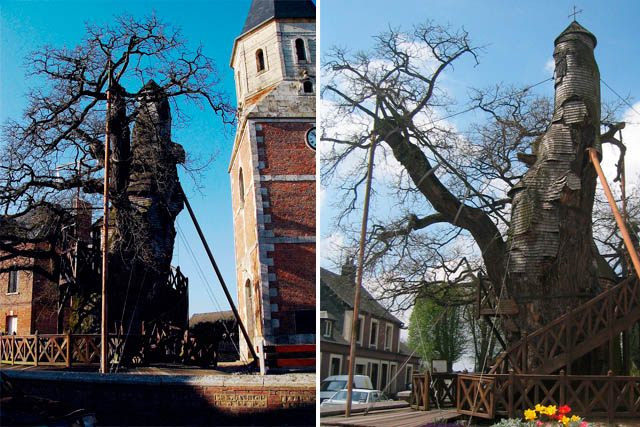
(images via 1, 2)
In the early 1660s, a 470-year-old oak tree in Allouville-Bellefosse, France, was struck and hollowed by a lighting strike. Not only did the tree survive this attack, but it came to the attention of Abbot Du Détroit and Father Du Cerceau. In 1669 they began building a shrine to the Virgin Mary directly inside the tree itself. Later a staircase climbing the outside of the tree was built and another chapel was added on a "second floor" of the tree.
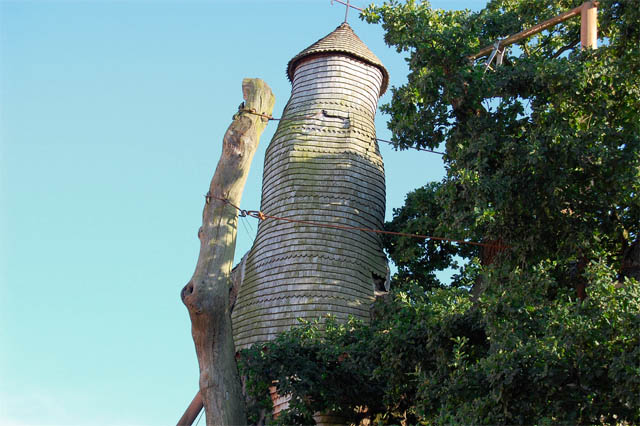
(image via)
Things almost took a very bad turn for the tree during the French revolution when a mob stormed the tree and threatened to burn down this symbol of the abhorred Church. A quick thinking local renamed the oak the "Temple of Reason," sparing it a fiery fate.

(images via)
Here we enter what could be called the modern period of botanical architecture. It begins in 1903, in Wisconsin with a banker named John Krubsack.
6. The Chair That Grew
One day in 1903, a friend admired a beechwood chair Krubsack had crafted, and complimented him on his handicraft. A man who perhaps didn't know how to take a compliment, Krubsack announced, "Dammit, one of these days I am going to grow a piece of furniture that will be better and stronger than any human hands can build." Fifteen years later, he had done just that, with every joint in his chair "cemented by nature."
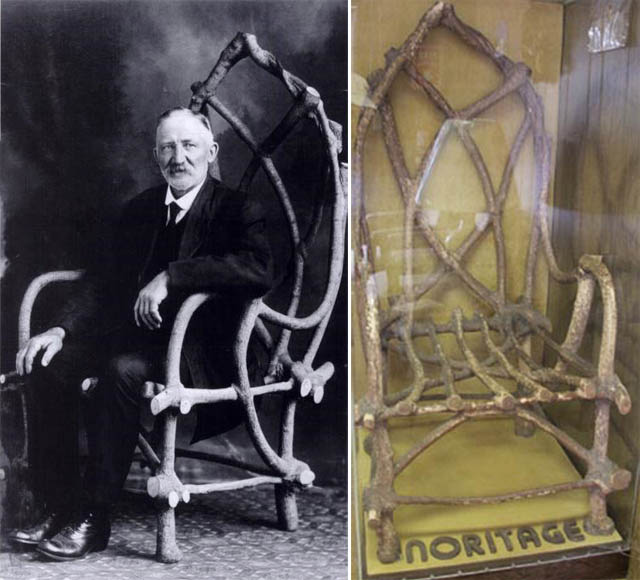
(images via 1, 2)
Though many handsome offers were made for the famous chair, Krubsack refused to sell, eventually leaving it to his nephew to be displayed in his furniture store. The "Chair that Grew" was last seen at the entrance of Noritage Furniture, owned by Krubsack’s descendants. The store recently closed, and the fate of the chair is unknown, but it likely still resides somewhere in the tiny town of Embarrass, WI, not far from where it grew nearly 100 years ago.

(images via 1, 2)
7. The Circus Trees of Axel Erlandson
Where Krubsack was a pioneer, Axel Erlandson was a visionary -- though he didn't know it at the time. Axel Erlandson never intended to create a new genre of sculpture or become the father of an art movement. He just wanted to entertain his family.
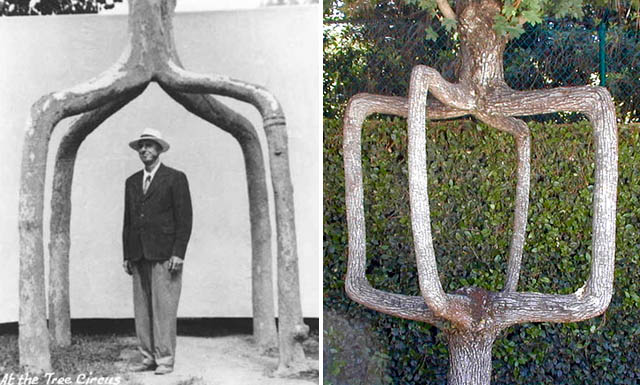
(images via 1, 2)
A farmer in California, Erlandson had noticed the curious property of trees to naturally graft themselves together. In 1925 Erlandson began creating plans for a series of trees that were purposely grafted together to create pleasing shapes. His first creation was the "Four Legged Giant," four trees which he merged into a single truck, creating a kind of tree-gazebo.
In 1945, twenty years after Erlandson had begun his hobby, his daughter suggested to her father that he might open some kind of "Tree Circus" to showcase his unusual arbor creations. Erlandson did just that, creating over 70 unique arborsculptures in his Tree Circus. Among his creations were a tree that split into a cube, an arch tree and a six-tree woven basket.
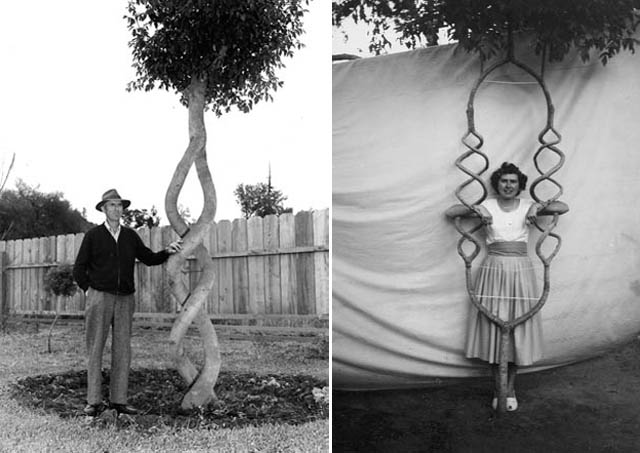

(images credit: Arborsmith.com)
The Tree Circus was a not much of a financial success, and in 1963 Erlandson sold the property, trees and all, and died shortly thereafter. It wasn't long before all 70 trees were forgotten and by 1977 only forty of the unique specimens remained. These were all scheduled to be bulldozed to create a mall.
Luckily for the trees, and for the world, they were saved from this fate by Michael Bonfante, owner of Nob Hill Foods. Bonfante, a horticultural connoisseur, opened a theme park and in 1985 relocated the trees to what is now known as Gilroy Gardens.
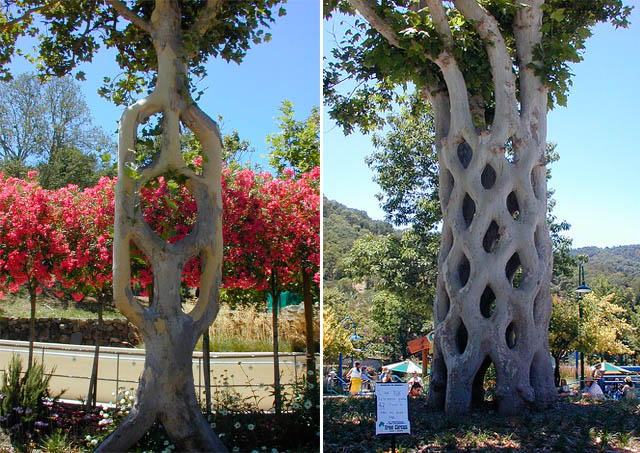
(images via 1, 2)
Today, 25 of Axel Erlandson's arborsculptural creations are on display at Gilroy, and Erlandson's first creation, the Four Legged Giant remains alive and well at the park, some 80 years after it was begun.
8. The Auerworld Palace
Many of these marvels are the works of one dedicated person, but the mysterious Auerworld Palace took some 300 volunteers to create. Architect Marcel Kalberer and his group, Sanfte Strukturen, are re-envisioning the way living building materials and techniques can be used to design modern spaces - with willows.
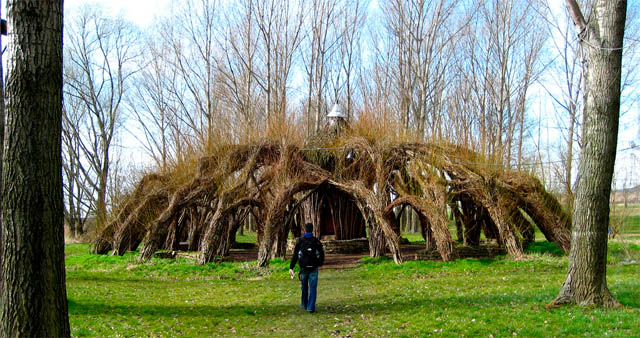
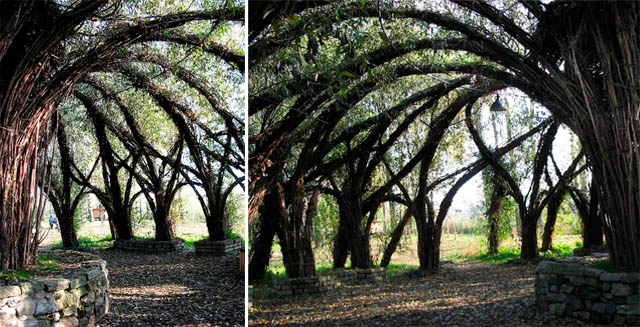
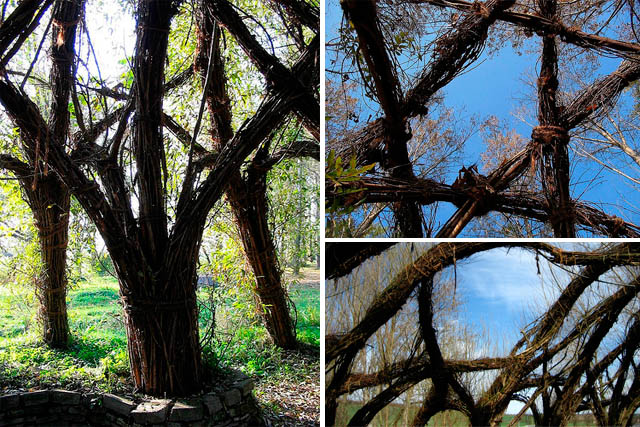
(images credit: SanfteStrukturen, via)
Constructed in 1998, the Auerworld Palace in Aeurstedt, Germany may be the first modern "willow palace," but the techniques Kalberer uses are ancient. Sumerian reed houses were famous for their construction of tightly bound reeds.
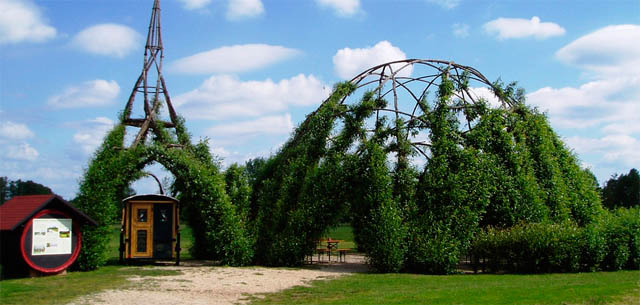
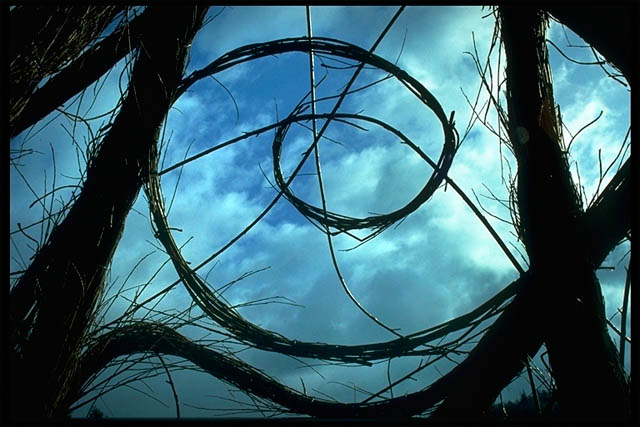
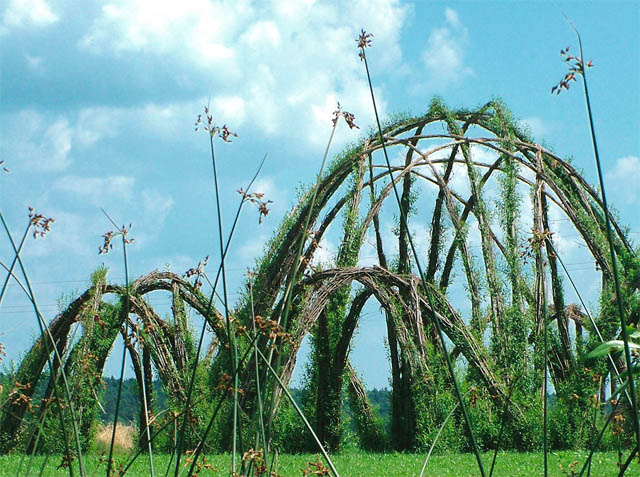
(other structures by Sanfte Strukturen - images via 1, 3)
Where Kalberer and his team create buildings out of trees, Hundertwasser has created a building inspired by, and incorporating, trees.
9. Waldspirale, or Forest Spiral
The Austrian artist and architect Friedensreich Hundertwasser is said to have once called straight lines "the devil's tools." His famous apartment building, Waldspirale, is a testament to his hatred of straight lines and his love of nature. Located in Darmstadt, Germany, Waldspirale translates to "wooded spiral," and that is exactly what it is. It hosts as many trees as human occupants.
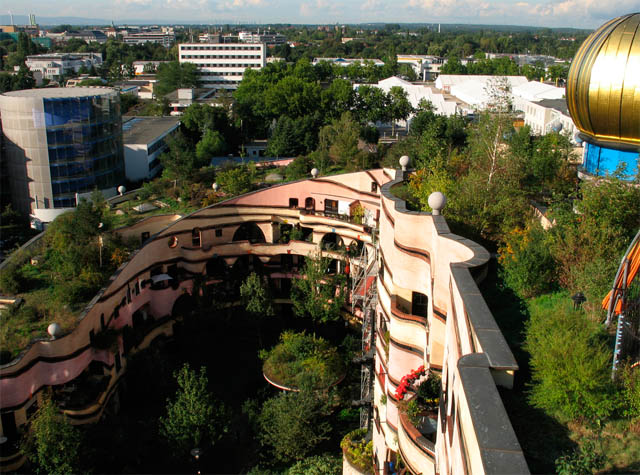
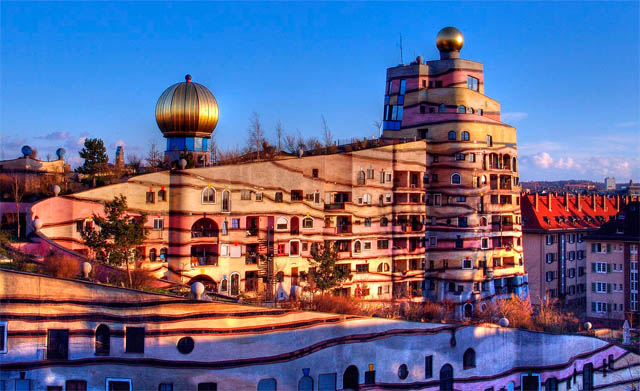
(images via 1, 2)
10. Modern Organic Forms
Today a growing number of tree grafters, arborsculptors and botanical architects are working to create new organic forms. Among them are Richard Reames who coined the phrases arborsculpture and arbortecture.
Richard Reames grows and shapes tree trunks using the ancient arts of grafting, framing, bending and pruning. Reames believes that his living arborsculptures could one day replace many of the things that trees are typically killed to make.
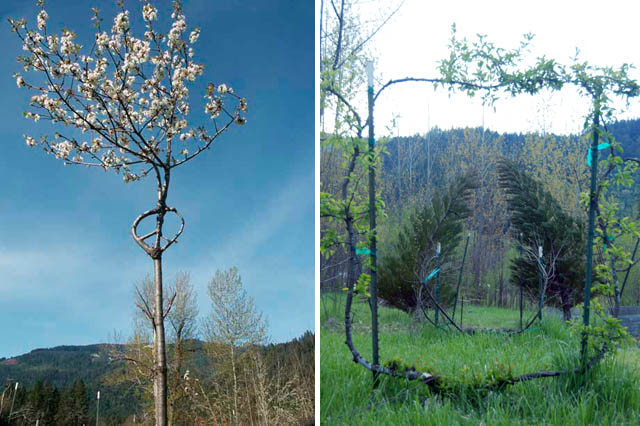

(images credit: Richard Reames)
Another absolutely wonderful tree grafter who has been working since before the form even had a name is Dan Ladd. Ladd crafts trees into whimsical shapes, and incorporates other objects into the trees.
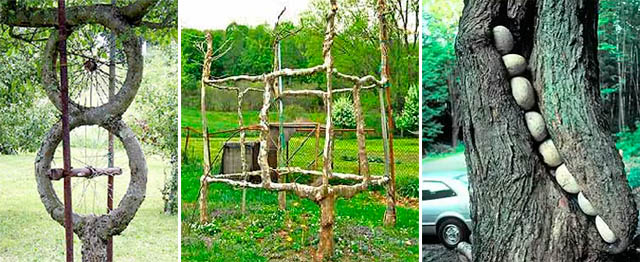
(images credit: Dan Ladd)
Ladd also practices the ancient art of gourd shaping. These are all gourds that were growin inside of forms. They have not been carved or altered after they were harvested.


(images credit: Dan Ladd)
Tree grafters Peter Cook and his wife Becky Northey, have developed their own special tree-shaping techniques, which they call pooktre.

(image credit: Peter Cook)
Among the many other artists working in the form are Konstantin Kirsch, Laura Spector, andAharon Naveh.
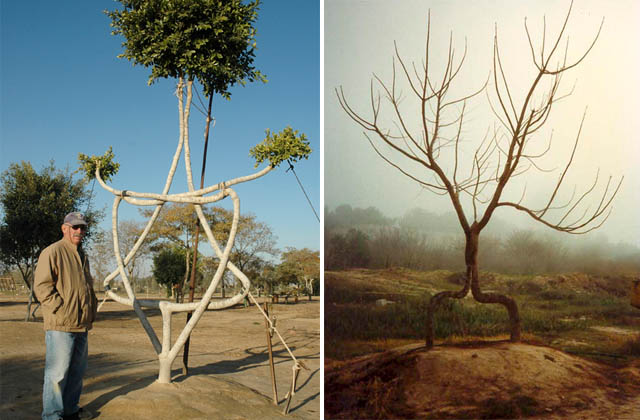
(images credit: Aharon Naveh)
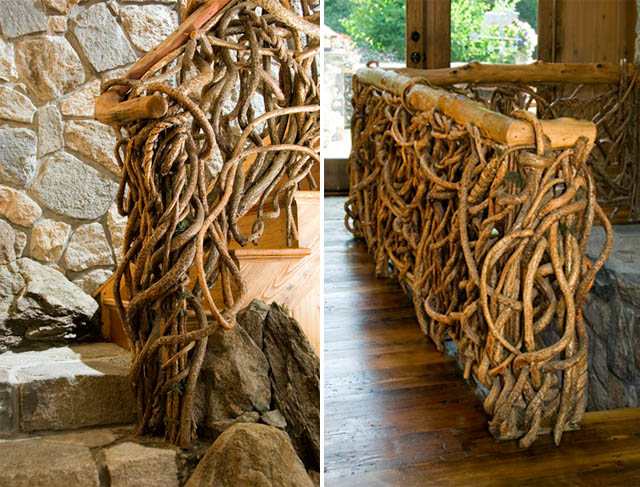
(Staircases by Laura Spector)
Best links on the subject and further reading: 1, 2, 3, 4, 5


